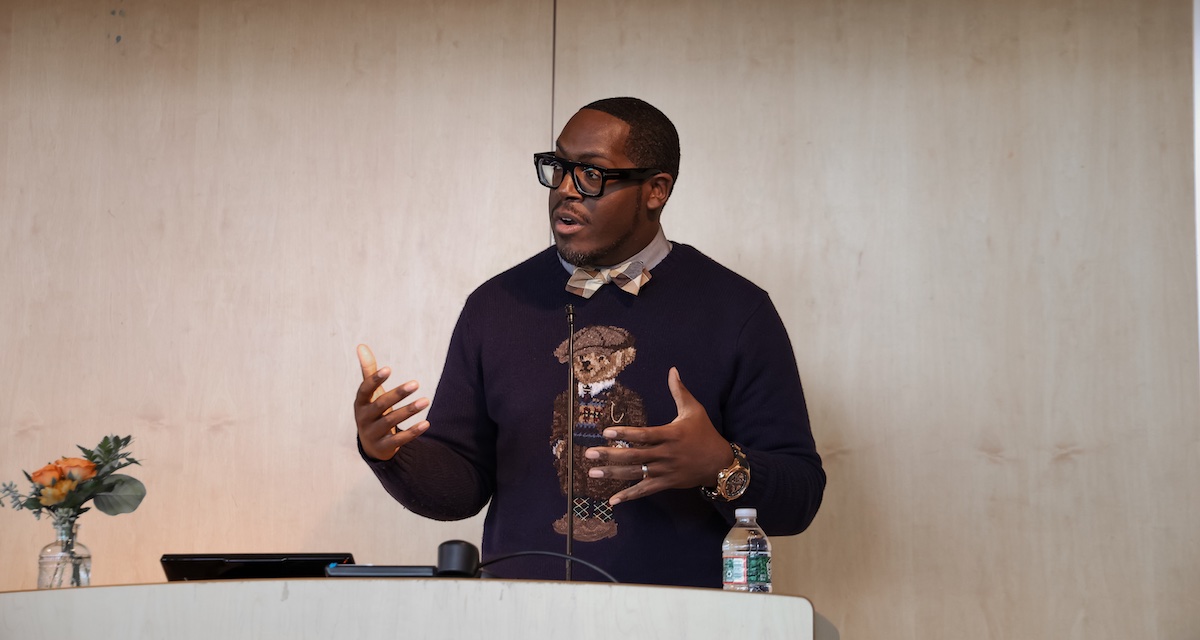Georgetown’s Steven Harris Explores Christian Fugitivity at Center for Faith and Inquiry Event
Is fugitivity heretical—or a potential mode of evangelical existence?
In the second Center for Faith and Inquiry lecture of the academic year, Steven Harris, a faith-based public policy expert and scholar of American religious history and African American studies, explored what we can learn from contradictions in American Christian history and the formation of what has been termed “the black church.”
Slavery and Christianity in American history
During the Revolutionary era many Americans were unwilling to apply revolutionary ideas to the issue of slavery, said Harris, who is the senior director of academic programs at Georgetown University’s Center on Faith and Justice. Slavery was expanding throughout the North and South in the 18th century, and both regions’ economies relied on it to survive.
Religious leaders of this period defended the presumption that Christianity and slavery were compatible. In this period, Harris noted, black people were “confronted with the pervasiveness of broader assumptions concerning both their spiritual state and intellectual abilities” and were “incapable of achieving the highest forms of expression of their mental faculties.”
Fast-forward to the first decades of the 19th century, when a significant number of slaves converted to Christianity because of “the ongoing revivalist mood coupled with the rise in visibility and effectiveness of Baptist and Methodist evangelism efforts.” This conversion was not easy due to its concurrence with “the second great awakening,” Harris explained, which propelled the expansion of the internal slave trade.
“[The] slave economy played [a large role] in the foundations of America’s economic capitalistic thriving,” he said. Slave owners and plantation missionaries sought to combine religious instruction with social and institutional control. In this period, “the actual degree of independence of these black churches, along with their ministers, was always limited by imposed restrictions.” It was difficult to find a mixed congregation, and even if there was, black worshipers had to sit in the back pews or in separate galleries.
Against this backdrop the “black church,” Harris explained, was born in protest against the slave trade, white supremacy and the issue of religious freedom.
What we can learn from the formation of the “black church”
As the “black church” pressed against imposed restrictions, it demonstrated that Christianity could thrive even without political power. And it highlighted the need for a “critical patriotism that hasn’t been wooed by the temptation to subject Christianity to the task of serving as custodian of national mythology,” Harris said.
Enter: Christian fugitivity. It is, Harris explained, “the recognized necessity of taking the outside for the sake of deep concern for the inside. It is a project of refusal that has as its end the goal of recovery.”
“Fugitive Christian practice,” he continued, “is often read as, or might be read as, heretical only in the sense that that which is considered orthodox or normative is illegitimately issuing the charge of heresy.” Christian fugitivity chooses to “go heretic” by pushing against politicization and embracing the margins.
Harris called for a “refusal to allow one’s Christian identity to become conflated with or totalizing defined by party affiliation.” As Christians, he emphasized, we need the power of the Holy Spirit, community and Christian fellowship that knows how to exist at the margins.
“In Christ you’ve been made free,” concluded Harris. “So don’t try to bind other individuals . . . It undermines the freedom that you’ve been granted.”
By Jasmine Yoo ’26 (marketing, business management)
 The Bell
The Bell